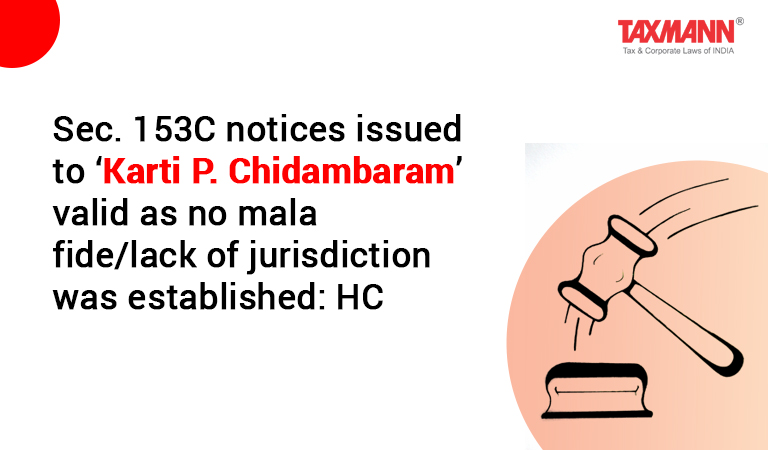Sec. 153C notices issued to ‘Karti P.Chidambaram’ valid as no mala fide/lack of jurisdiction was established: HC
- Blog|News|Income Tax|
- 2 Min Read
- By Taxmann
- |
- Last Updated on 15 July, 2021
Case details: Karti P. Chidambaram v. PDIT - [2021] 128 taxmann.com 116 (Madras)
Judiciary and Counsel Details
-
- S.M. Subramaniam, J.
- Abhishek Singhvi, K.V. Viswanathan, Sr. Counsel, N.R.R. Arun Natarajan, Amit Bhandari, R.V. Easwar, Ms. Rubal Bansal, AR.L. Sundaresan and Ms. C. Uma for the Petitioner
- R. Sankaranayanan, A.P. Srinivas and A.N.R. Jayaprakash for the Respondent
Facts of the Case
Assessee-Karti P. Chidambaram had sold his land measuring 5.11 acres by three sale deeds and disclosed the capital gains in return of income (ITR). Assessing Officer (AO) initiated reassessment pursuant to the search conducted at buyer’s premises. However, later on, he issued notices under section 153C on basis of information received from DDIT (Inv.) related to search and seizure operations conducted at the buyer’s premises.
Assessee contended that AO elected to initiate proceedings under Section 153C merely on basis of information received from Inv. wing. He was well aware of the search action but he slept over the matter for a considerable length of time without any action and woke up one fine morning and issued the notices under section 153C. Such an action was not only legal malice, but without jurisdiction.
High Court Held
The Madras High Court has held that the scope of judicial review under Article 226 of the Constitution of India is to scrutinize the processes and procedures through which a decision is arrived in consonance with the provisions of the Statutes by the competent authority, but not the decision itself. The authority competent must be allowed to scrutinize the searched and impounded materials and provide an opportunity to the assessee to defend his case. Such an adjudicatory process alone would provide justice to the parties to the lis.
It was for the assessee to defend his case before the competent authority by submitting the documents and evidence and establish his case both based on the provisions of the Act and facts. At the stage of Show Cause Notice (SCN), High Court would not enter into the venture of conducting an adjudication of disputed facts. It is the duty of the fact-finding authority to adjudicate the facts and arrive at a conclusion. Thus, the ground of legal malice was not established by the petitioners, to set aside the SCN.
A writ may be entertained if the SCN was issued without jurisdiction or on malafide grounds. In the given case, no malafide or lack of jurisdiction was identified or established by the assessee, and thus, the point raised in this regard stands rejected.
Disclaimer: The content/information published on the website is only for general information of the user and shall not be construed as legal advice. While the Taxmann has exercised reasonable efforts to ensure the veracity of information/content published, Taxmann shall be under no liability in any manner whatsoever for incorrect information, if any.

Taxmann Publications has a dedicated in-house Research & Editorial Team. This team consists of a team of Chartered Accountants, Company Secretaries, and Lawyers. This team works under the guidance and supervision of editor-in-chief Mr Rakesh Bhargava.
The Research and Editorial Team is responsible for developing reliable and accurate content for the readers. The team follows the six-sigma approach to achieve the benchmark of zero error in its publications and research platforms. The team ensures that the following publication guidelines are thoroughly followed while developing the content:
- The statutory material is obtained only from the authorized and reliable sources
- All the latest developments in the judicial and legislative fields are covered
- Prepare the analytical write-ups on current, controversial, and important issues to help the readers to understand the concept and its implications
- Every content published by Taxmann is complete, accurate and lucid
- All evidence-based statements are supported with proper reference to Section, Circular No., Notification No. or citations
- The golden rules of grammar, style and consistency are thoroughly followed
- Font and size that’s easy to read and remain consistent across all imprint and digital publications are applied








 CA | CS | CMA
CA | CS | CMA


